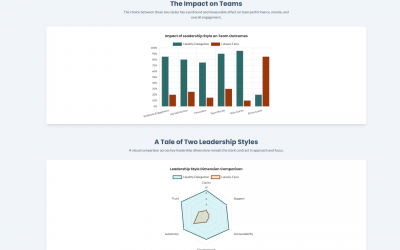Locus of Control: The Mindset That Separates Accountable Leaders from the Rest
The Pervasive Accountability Gap
“Leaders inspire accountability through their ability to accept responsibility before they place blame.” – Courtney Lynch.
This sentiment captures an ideal that stands in stark contrast to the reality within most organizations. A significant gap exists between the recognized importance of leadership accountability and its actual practice. A global survey revealed that while 72% of executives believe leadership accountability is a critical business issue, a mere 31% are satisfied with the level of accountability demonstrated by their leaders. This chasm points to a global leadership crisis, with further research showing that 82% of managers admit they either try and fail to hold others accountable or avoid it entirely.
This widespread failure is not a simple skill deficit. It points to a deeper, more fundamental aspect of a leader’s psychology—their core operating system for interpreting the world. When leaders believe that outcomes are dictated by forces beyond their control, no amount of process-based initiatives can succeed. The root cause is a leader’s belief system about their own agency. Understanding this belief system—this Locus of Control—is the first and most critical step toward closing the accountability gap for good.
The Psychology of Ownership
At the heart of a leader’s approach to accountability is a psychological concept known as Locus of Control (LoC), developed by Julian B. Rotter in the 1950s. It refers to an individual’s belief about the underlying causes of events in their life, answering the question: “Am I the master of my fate, or am I a product of my circumstances?”. This belief system dictates how a leader perceives challenges, interprets success and failure, and ultimately, exercises their leadership.
Locus of Control is a continuum with two primary orientations :
- Internal Locus of Control (“The Architect”): This reflects the belief that one’s own actions and efforts are the primary drivers of outcomes. Individuals with a strong internal LoC see themselves as active agents, taking responsibility for both successes and failures. When they succeed, they credit their hard work; when they fail, they analyze their own missteps to learn from them.
- External Locus of Control (“The Passenger”): This is the belief that outcomes are determined by outside forces like luck, fate, or powerful others. Individuals with a strong external LoC often feel powerless, attributing success to good fortune and blaming failure on external factors, absolving them of personal responsibility.
A leader’s dominant orientation has profound implications. It is the psychological bedrock upon which key competencies like accountability, resilience, and strategic thinking are built, shaping a leader’s every decision and, by extension, the performance and culture of their organization.
From Self-Awareness to Organizational Performance
Understanding Locus of Control is a strategic imperative. Its importance stems from its role as a foundational element of self-awareness and its powerful ripple effect across an organization.
LoC as the Foundation of Leadership Self-Awareness
Deep self-awareness requires metacognition—thinking about one’s own thinking. Understanding your Locus of Control is a powerful form of metacognitive self-awareness, revealing how you fundamentally think about your own agency in the world. This awareness is critical because a leader’s LoC is linked to other vital psychological drivers of success, including a higher sense of self-efficacy, a growth mindset, and greater self-control.
The Ripple Effect: How a Leader’s LoC Shapes the Organization
A leader’s Locus of Control is constantly broadcast through their language and actions, setting the cultural tone. It determines whether they cultivate a culture of ownership or one of blame.
| Leadership Dimension | Internal LoC (“The Architect”) | External LoC (“The Passenger”) |
|---|---|---|
| Core Belief | “I am responsible for the outcomes.” | “Outcomes are determined by outside forces.” |
| Response to Setbacks | Takes ownership, analyzes missteps, seeks lessons. | Blames external factors, feels powerless. |
| Decision-Making | Proactive, decisive, takes calculated risks. | Reactive, hesitant, risk-averse. |
| Team Empowerment | Fosters autonomy, delegates authority. | Micromanages, centralizes control. |
| Impact on Culture | Creates agency, resilience, and high engagement. | Fosters helplessness, passivity, and low morale. |
The Performance Imperative
Ultimately, the most compelling reason to focus on Locus of Control is its link to the bottom line. Research consistently finds that firms led by CEOs with an internal LoC perform better and are more likely to be transformational leaders who drive innovation. The stakes are incredibly high. A six-year study of 39 small firms found that among those led by CEOs with an external LoC, 45% went bankrupt. In stark contrast, only 7% of firms led by internal CEOs failed. This suggests a leader’s internal belief in their own agency can be the critical factor in organizational survival.
Rotter’s Social Learning Theory in the Boardroom
Locus of Control is a core component of Julian B. Rotter’s Social Learning Theory. The theory posits that our behavior is shaped by “reinforcements”—the rewards and punishments we experience. Over time, we develop a “generalized expectancy” about the relationship between our actions and their outcomes.
- If our efforts consistently lead to positive reinforcement, we develop an internal Locus of Control.
- If outcomes seem random or dependent on others, we develop an external Locus of Control.
The most critical implication of Rotter’s theory is that Locus of Control is largely learned, not fixed, and therefore can be modified and developed. This transforms LoC from a diagnostic category into a powerful lever for leadership development. Instead of simply training a leader on “how to act more accountably” (a behavioral patch), a more profound intervention is to help them fundamentally shift their underlying belief system about their own power and influence. It moves the conversation from “This is the kind of leader you are” to “This is the kind of leader you can become.”
Leadership Mindsets in a Crisis
To illustrate the impact of Locus of Control, consider two leaders facing the same threat.
The Parable of the Two CEOs
An established company, “Innovate Corp,” is threatened by a disruptive new technology.
CEO Alex: “The Architect” (Internal Locus of Control)
Alex’s mindset is one of ownership. He thinks, “This is a formidable challenge, but one we will navigate. Our past success led to complacency, and I own that. Our response will determine our future”. His actions are proactive. He convenes the team for an honest assessment, publicly takes responsibility, and reallocates 30% of the budget to a new R&D unit. He relentlessly focuses the organization on its “circle of control”—what each team can do right now to build the future. He is building a new reality.
CEO Ben: “The Passenger” (External Locus of Control)
Ben’s mindset is one of victimhood. He thinks, “We’ve been blindsided. There’s not much we can do but cut costs and hope this storm passes”. His actions reflect this powerlessness. His meetings are filled with external blame—the “predatory pricing” of the startup, the “unforgiving” economy. His strategy is purely defensive: travel freezes and halts R & D. He micromanages, creating a bottleneck that paralyzes the organization. Ben’s company is not navigating the storm; it is adrift.
Real-World Examples in Leadership
- Jack Welch (General Electric): Welch’s tenure as CEO is a masterclass in applying an aggressive internal Locus of Control. He believed GE’s destiny could be radically forged through decisive action. His famous initiatives—being “#1 or #2” in every market, creating a “boundaryless organization,” and the “vitality curve”—all stemmed from a core belief that he and his leaders were in complete control of the company’s performance.
- Satya Nadella (Microsoft): Nadella offers a more contemporary model of internal LoC. He took over a company losing ground in key technology shifts. His leadership demonstrates a powerful internal LoC tempered with empathy and a “learn-it-all” growth mindset. He believes leaders must “create clarity when none exists” and “drive success in what is an overconstrained world”—hallmark statements of an internal orientation. He focused on fostering psychological safety and collaboration to build an innovative culture.
Practical Strategies for Cultivating an Internal Locus of Control
Developing an internal LoC requires deliberate practice. The following strategies provide a practical toolkit for shifting from a passive to an active mindset.
Strategy 1: Master Your Mindset with the “Circles of Control”
This exercise refocuses mental energy.
- Action: Draw three concentric circles.
- Inner Circle – Direct Control: List things you have direct control over (e.g., your effort, attitude, decisions).
- Middle Circle – Influence: List things you can influence but not control (e.g., team motivation, client decisions).
- Outer Circle – No Control: List things you have no control over (e.g., the global economy, competitor moves).
- Principle: Deliberately shift your focus and actions toward the inner two circles. Asking, “What is the most effective action I can take within my circle of control or influence right now?” builds the mental habit of agency.
Strategy 2: Reframe Your Language from Blame to Ownership
Language shapes and reinforces beliefs.
- Action: For one week, audit the language used by yourself and your team. Replace phrases of external blame with phrases of internal ownership.
- Instead of: “We couldn’t meet the deadline because the other department was late.”
- Say: “We didn’t build enough buffer into our project plan. How can we improve our planning process?”
- Principle: Each time a leader reframes a statement from blame to ownership, they model accountability and reinforce a new, more powerful mindset for the team.
Strategy 3: Deconstruct Goals to Build Agency
Large goals can feel overwhelming. Breaking them down creates a clear path of action.
- Action: Deconstruct a major annual objective into quarterly, monthly, and weekly tasks. Celebrate the achievement of these smaller steps with the team.
- Principle: While a goal like “Increase market share by 10%” can feel daunting, an action like “Make five outreach calls this week” is clearly within direct control. Completing small, controllable actions provides tangible proof that one’s efforts lead to progress, strengthening the belief in personal agency.
Strategy 4: Treat Feedback as Fuel, Not Judgment
A leader’s reaction to feedback indicates their LoC.
- Action: Proactively seek feedback. When receiving criticism, suppress the instinct to defend and instead adopt a posture of curiosity. Ask clarifying questions to understand the other perspective.
- Principle: Those with an external LoC often avoid or dismiss negative feedback. In contrast, those with an internal LoC actively seek it out, viewing it as critical data needed to adjust their approach and increase control over future outcomes.
Strategy 5: Empower to Create Empowerment
A leader’s LoC directly influences their team’s LoC.
- Action: Delegate a project you would normally manage closely. Grant full autonomy, provide resources, clarify the desired outcome, but do not dictate the process. State clearly, “I trust your judgment to get this done.”
- Principle: Every act of empowerment sends a powerful message: “I believe you are in control.” This trust creates the conditions for team members to develop their own sense of agency and ownership.
Critical Reflection for Leaders
Internalizing Locus of Control requires deep reflection. Use the following questions to move from passive reading to active introspection.
- The Post-Mortem Test: Think back to the last significant project failure. Was the focus on an external analysis (“What went wrong out there?”) or an internal retrospective (“What could we have done differently?”)?
- The Success Attribution Test: Consider your team’s last major win. Was success attributed to external factors like “We got lucky,” or to internal factors like “Our innovative strategy and disciplined execution made this happen”?
- The Autonomy Audit: How many layers of approval are required for a small decision? Do team members feel they need to ask for permission, or are they empowered to take initiative?
- The “Uncontrollable” Check-in: Identify a major challenge you feel is “out of your hands.” Apply the Circles of Control exercise. Are there any aspects within your circle of influence or direct control that you have been overlooking?
The “Locus of Control Shift” Journal
Objective: To build the habit of reframing events from an external to an internal perspective and linking this new perspective to concrete action.
Instructions: For the next two weeks, commit to a daily 5-minute journaling practice. Each day, identify one significant event and complete the following three prompts:
- The “External” Narrative (The Passenger’s View): Write one sentence describing the event as if it were caused by external forces.
- The “Internal” Narrative (The Architect’s View): Rewrite that sentence to reflect total internal ownership and agency.
- The Actionable Insight: Based on your “Internal” narrative, answer: “What is one specific action I can take to increase my control over a similar outcome in the future?”
Rationale: This exercise builds awareness of your default narrative, provides practice in the cognitive skill of reframing, and connects that shift to a concrete, future-oriented action, building the habit of agency one day at a time.
Leading from Within
Locus of Control is the engine of leadership accountability. It dictates whether a leader acts as an architect of their organization’s future or a passenger subject to circumstance. An external LoC fosters a culture of blame and passivity, while an internal LoC is the wellspring of ownership, resilience, and proactive problem-solving. The evidence is unequivocal: leaders with a strong internal LoC are more innovative, effective, and resilient, and they build teams that deliver superior performance. The crucial insight is that LoC is not a fixed destiny but a learned orientation. By mastering their mindset, leaders can consciously shift their own orientation and, in doing so, transform their teams’ culture. This is the foundational work required to close the accountability gap and lead from within.
Suggested Readings & Resources
For Foundational Concepts
- Book: Choice or Chance: Understanding Your Locus of Control and Why it Matters. Stephen Nowicki. May 17, 2016. This book explains the psychological concept of locus of control, which determines whether you believe your life is governed by your own actions or by external factors like luck and fate. It argues that developing a more internal locus of control, the belief that you are in charge of your own destiny, is crucial for achieving success and personal well-being.
For Practical Application in Organizations
- Book: The Oz Principle: Getting Results Through Individual and Organizational Accountability by Roger Connors, Tom Smith, and Craig Hickman. A classic that provides a practical framework for creating a culture of accountability.
- Book: Accountability Leadership: How Great Leaders Build a High-Performance Culture of Accountability and Responsibility by Dianne Worrall. A modern guide with actionable solutions for transforming accountability into a positive force.



